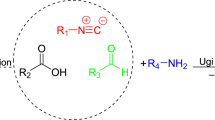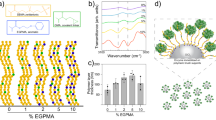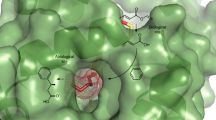Abstract
Escherichia coli, having high aspartase activity, were immobilized by covalent attachment and entrapment with polyazetidine with .retention of 97% of the free cell activity. The projected enzyme half-life was 611 days. Stability of the system was greater than 2 years at 25°C without loss of activity when stored in 1.5 M ammonium aspartate. The system provides attractive benefits for the commercial production of specialty chemicals.
This is a preview of subscription content, access via your institution
Access options
Subscribe to this journal
Receive 12 print issues and online access
$209.00 per year
only $17.42 per issue
Buy this article
- Purchase on Springer Link
- Instant access to full article PDF
Prices may be subject to local taxes which are calculated during checkout
Similar content being viewed by others
References
Chibata, I., Tosa, T. and Sato, T. 1979. Use of immobilized cell systems to prepare fine chemicals, p. 433–461. In: Microbial Technology, Vol. 2; Fermentation Technology. H.J. Peppier, D. Perlman (eds.), Academic Press, NY.
Chibata, I. 1983. Industrial production of optically active compounds using immobilized biocatalysts, p. 465–496. In: Basic Biology of New Developments in Biotechnology. A. Hollaender, A. I. Laskin, P. Rogers (eds.). Plenum Press, New York.
Tosa, T., Sato, T., Mori, T., Matsuo, Y. and Chibata, I. 1973. Continuous production of L-aspartic acid by immobilized aspartase. Biotech. Bioeng. 15: 69–84.
Chibata, I., Tosa, T. and Sato, T. 1974. Immobilized aspartase containing microbial cells: preparation and enzymatic properties. Appl. Micro. 27: 878–885.
Tosa, T., Sato, T., Mori, T., Yamamoto, K., Takata, I., Nishida, Y. and Chibata, I. 1979. Immobilization of enzymes and microbial cells using carrageenan as matrix. Biotech. Bioeng. 21: 1697–1709.
Takata, I., Tosa, T. and Chibata, I. 1977. Screening of a matrix suitable for immobilization of microbial cells. J. Solid-Phase Biochem. 2: 225–236.
Nishida, Y., Sato, T., Tosa, T. and Chibata, I. 1979. Immobilization of Escherichia colt cells having aspartase activity with carrageenan and locust bean gum. Enzyme Microbial Tech. 1: 95–99.
Sato, T., Mori, T., Tosa, T., Chibata, I., Furui, M., Yamashita, K., and Sumi, A. 1975. Engineering analysts of continuous production of L-aspartic acid by immobilized Escherichia coli cells in fixed beds. Biotech. Bioeng. 17: 1797–1804.
Sato, T., Nishida, Y., Tosa, T. and Chibata, I. 1979. Immobilization of Escherichia coli containing aspartase activity with K-carrageenan. Enzymic properties and application for L-aspartic acid production. Biochim. et Biophys. Acta 570: 179–186.
Fusee, M.C., Swann, W.E. and Gallon, G.J. 1981. Immobilization of Escherichia coli cells containing aspartase activity with polyurethane and its application for L-aspartic acid production. Appl. Environ. Micro. 42: 672–676.
Guthrie, J.L., Great Britain Patent Application 2,152,1432, August 16, 1983.
Author information
Authors and Affiliations
Rights and permissions
About this article
Cite this article
Wood, L., Calton, G. A Novel Method of Immobilization and its Use in Aspartic Acid Production. Nat Biotechnol 2, 1081–1084 (1984). https://doi.org/10.1038/nbt1284-1081
Received:
Accepted:
Issue Date:
DOI: https://doi.org/10.1038/nbt1284-1081
This article is cited by
-
The Production of L–Phenylalanine by Polyazetidine Immobilized Microbes
Nature Biotechnology (1986)



